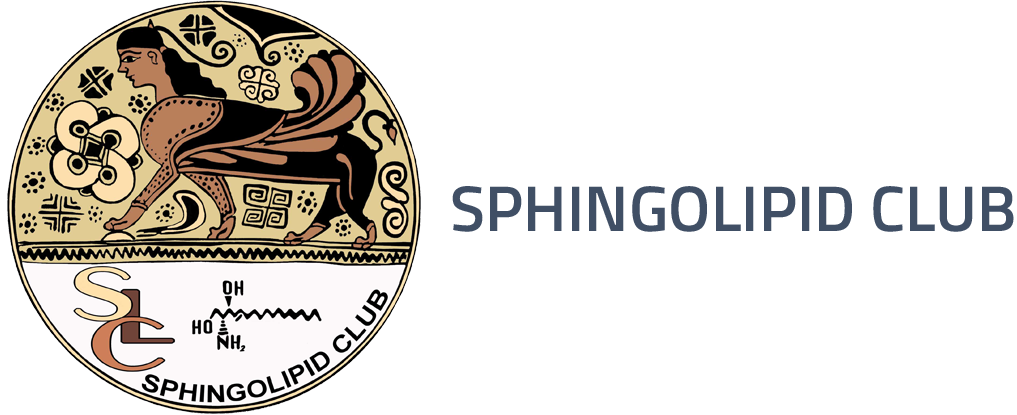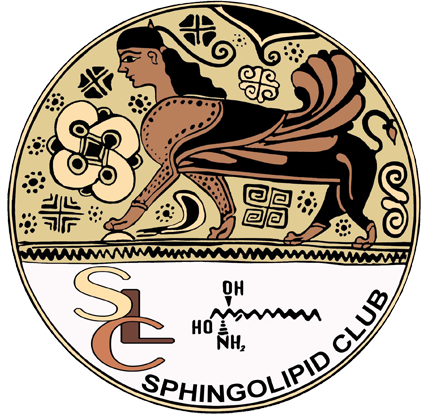10th Meeting
Assisi, Italy, June 27-30, 2013
Oral Presentations
OP1
María Garrido1, José Luis Abad1, Alicia Alonso2, Antonio Delgado1,3, L. Ruth Montes2, Félix M. Goñi2
1Consejo Superior de Investigaciones Científicas (CSIC), Institut de Química Avançada de Catalunya (IQAC), Research Unit on Bioactive Molecules (RUBAM). Jordi Girona 18‑26, 08034 Barcelona, Spain.2Unidad de Biofísica (CSIC-UPV/EHU), and Departamento de Bioquímica, Universidad del País Vasco, Aptdo. 688, 48080 Bilbao, Spain.L. Ruth Montes, Phone: +34 946 018 050, Email: lidiaruth.montes@ehu.es3Universidad de Barcelona, Facultad de Farmacia, Unidad de Química Farmacéutica, Avda. Joan XXIII s/n, 08028 Barcelona, Spain.
Ceramide analogues containing azide groups either in the polar head or in the hydrocarbon chains are non-fluorescent. When incorporated into phospholipid bilayers they can react in situ with a non-fluorescent 1,8‑naphtalimide using click chemistry giving rise to fluorescent ceramide derivatives emitting at ≈440 nm. When incorporated into giant unilamellar vesicles, two-photon excitation at 760 nm allows visualization of the ceramide-containing bilayers. This kind of method may be of general applicability in the study of membrane and cell membranes.
OP2
Torretta E. 1, Vasso M. 1,2 , Fania C. 1, Capitanio D. 1, Bergante S. 1,3, Piccoli M. 1,3, Anastasia L. 1,3, Gelfi C. 1,2
1 Department of Biomedical Sciences for Health, University of Milan, Segrate (Milan), Italy; 2 Institute of Molecular Bioimaging and Physiology (IBFM), CNR, Cefalù (Palermo) Segrate (Milan), Italy; 3 Laboratory of Stem Cells for Tissue Engineering, IRCCS Policlinico San Donato (Milan), Italy
Glycosphingolipids are a wide class of ubiquitous lipids, characterized by a great structural and functional variety. Altered levels have been correlated with different diseases, suggesting their crucial role in health. To date, characterization is mainly based on TLC, followed by antigen antibody reactions or by radioactive labelling. Recently, new mass spectrometry strategies have been developed. Herein we set up an online HPTLC-MALDI method combining high resolving power and mass accuracy.
Different matrices solutions were tested to set up the best conditions for matrix delivery to improve GSLs detection, resulting in DHB matrix in 50% acetonitrile as the best matrix, 50mg/mL for neutral GSLs and 100 mg/mL for acidic GSLs. Calibration curve of a neutral GSL (Gb3) and of a ganglioside (GM3) were constructed to demonstrate the applicability of HPTLC-MALDI method to quantitative analyses. The aqueous and organic phases extracted from wild-type and overexpressing NEU3 sialidase C2C12 murine myoblasts, were analysed by HPTLC, followed by MALDI-TOF and results compared to [3H]sphingolipids radiolabeled HPTLC. MS resolution allowed to identify several species with similar retention factor on the HTPLC plate, and that could not be resolved with the radiolabelling. Neutral GSLs (SM, Gb3, LacCer, GlcCer) and gangliosides (GM1, GM2, GM3, GD1a) were identified as C16:0, C22:0, C24:1 and C24:0 chains. GM3, the physiological substrate of NEU3, is decreased in NEU3 over-expressing cells, as assessed by radioactive quantitative measurements. Interestingly, by HPTLC-MALDI, spectra indicated that two GM3 isoforms decreased (d18:1 C16:0 and d18:1 C22:0) while d18:1 C24:1 increased.
HPTLC-MALDI is an easy and high-throughput analysis for the qualitative and quantitative characterization of GSLs suggesting its use for their profiling with high specificity and sensitivity.
OP3
Ingrid Nieves1, Ruth Montes2, Jesús Sot2, Alicia Alonso2, José Luís Abad1, Antonio Delgado1,3
1Research Unit on Bioactive Molecules (RUBAM), Dept. of Biomedicinal Chemistry, IQAC-CSIC, Barcelona, Spain; 2University of País Vasco, Dept. of Biochemistry, Unit of Biophysics, CSIC‑UPV/EHU, Bilbao, Spain
3University of Barcelona, Faculty of Pharmacy, Unit of Pharmaceutical Chemistry (Associated Unit to CSIC), Barcelona, Spain.
Experiments with bioactive sphingolipids (SLs) in model membranes are currently hampered by a lack of adequate experimental conditions able to mimic the physiological environment. To analyze membrane microdomains that are temporarily enriched in certain lipids, it is necessary to employ high molar concentrations of SLs analogues, or fluorescence tags that strongly influence the properties of lipid bilayers, such as BODIPY or NBD. Herein, we describe the synthesis of a series of GABA-polyene-n‑Doxyl fluorescent probes, specifically designed as biochemical tools to allow the study of model membranes at low lipid concentrations, closer to physiological conditions. These compounds contain a fluorescent polyene system, acylated with an internal n‑Doxyl radical able to act as a fluorescence quencher. This probe has enabled the development of a simple biophysical method to experimentally identify the formation of lipid domains. Thus, fluorescence of the GABA-polyene-n‑Doxyl system depends on the rigidity or fluidity of the lipid environment. The absorption and fluorescence properties of the probes, when incorporated into artificial vesicles, were monitored by espectrofluorimetry (for LUVs) or by fluorescence confocal microscopy (for GUVs). Preparation of rigid‑ordered liposomes with DSPC or DPPC showed a decrease of the fluorescence intensity versus fluid-disordered membranes of DOPC or eggPC. Moreover, it was observed that the conformational mobility of the n-Doxyl group was crucial for intramolecular fluorescence quenching, a property that was used as diagnostic to determine the characteristics of the membrane phosphoglycerolipids.
As a result, GABA-polyene-nDoxyl compounds may be of utility as novel fluorescent lipid probes to identify rigid-fluid domains in model membranes.
OP4
Andrea Lazzarini1,2 Elisabetta Albi1*†, Giuseppina Perrella2† , Remo Lazzarini1, Samuela Cataldi1, Alessandro Floridi1, Emanuela Floridi1, Francesco Saverio Ambesi-Impiombato2, Francesco Curcio2
1 Laboratory of Nuclear Lipid BioPathology, Research Center of Biochemical-Specialized Analyses CRABioN, 06100 Perugia (Italy); 2Department of Clinical and Biological Sciences, University of Udine, 33100 Udine (Italy)
In cell nucleus the sphingomyelin (SM) cycle is regulated by an exact internal mechanism. In no-stimulated cells exist a balance between neutral-sphingomyelinase (N-SMase) and sphingomyelin-synthase (SM-synthase) activity that maintains constant the SM level, stabilizing the double helix of DNA thanks to the trimethylammonio group that binds to the phosphate group of DNA and apolar fatty acids that bind to the hydrophobic centres of the helical DNA. The increase of the nuclear SM concentration during cell proliferation stimulates the SMase activity during the S phase of the cell cycle, thus favouring the destabilization and the opening of the double helix of DNA and the beginning of its synthesis. The winding of a double helix being restored as soon as DNA synthesis finishes and SM-synthase activity is stimulated. During apoptosis specific the gene expression and DNA fragmentation are accompanied by the change of nuclear SM content. Recently the nuclear N-SMase/SM-synthase ratio was considered a marker of cell function. In fact it was very high in apoptotic cells, medium in pro-apoptotic cells, low in proliferating cells and very low in quiescent cells. Here we studied for the first time whether in thyroid FRTL-5 cells the proton beams could change nuclear SM metabolism by comparing the results with that occurred in nuclei-free lysates (NFL) at the end to identify their role on functional state of the cells. In the nucleus proton beams stimulated 1.09 times N-SMase activity and inhibited 1.9 times that of SM-synthase in nuclei purified from quiescent cells whereas stimulated 12.44 times N-SMase activity and unchanged that of SM-synthase. The effect was very low in NFL lipid enzymes. As a consequence, the nuclear N-SMase/SM-synthase ratio was 1.06 and 1.77 in nuclei of quiescent and proliferating cells respectively, indicating that protons induced quiescent cells in a propaoptotic state whereas its value in proliferating cells was between the proapoptotic state and apoptotic state, as supported by bax expression that was higher in proliferating than in quiescent cells. The analysis of nuclear SM and ceramides by UFLC-MS/MS showed the variation of these lipids after proton treatment. In conclusion, the damage of proton beams on epithelial thyroid cells depends on their physiological state, whether they are stimulated or not with thyrotropin to proliferate. The nuclear SM metabolism is involved in the mechanism of action of protons.
OP5
Gemma Fabrias,1 José Luis Abad,1 Josefina Casas,1 Maria Garrido,1 Ingrid Nieves,1 Pedro Rayo,1 and Antonio Delgado1,2
1Consejo Superior de Investigaciones Científicas (CSIC), Institut de Química Avançada de Catalunya (IQAC-CSIC), Research Unit on Bioactive Molecules (RUBAM), Barcelona, Spain. 2Universidad de Barcelona (UB), Facultad de Farmacia, Unidad de Química Farmacéutica (Unidad Asociada al CSIC), Barcelona, Spain.
Progress in the understanding of sphingolipid metabolism and functions has benefited from the contribution of chemistry. Structural analogs, enzyme inhibitors and receptor agonists and antagonists have been employed as pharmacological tools and some of them have reached relevance in a therapeutic context.
An overview of recently reported compounds of use in sphingolipid research is given in this talk. Furthermore, unpublished ongoing studies carried out with novel 1-deoxysphingolipid analogs are presented. Biological screening of these analogs has revealed the appropriateness of some of the compounds as probes to profile ceramide synthase activities in intact cells, while potent and selective neutral ceramidase inhibitory activity has been disclosed by other molecules of the library. Future directions include the development of suitably functionalized derivatives amenable to orthogonal reactions with fluorescence tags for subcellular trafficking studies.
OP6
Carlotta Fabiani 1, Anna Caretti 1, Annalisa Guala 1, Josefina Casas 2, Gemma Fabriàs 2, Riccardo Ghidoni 1, Paola Signorelli 1.
1 , Department of Health Sciences, University of Milan, San Paolo Hospital, Italy;2, Research Unit on BioActive Molecules, Department of Biomedicinal Chemistry, Catalan Institute of Advanced Chemistry (IQAC/CSIC), Barcelona, Spain.
Sphingolipids have crucial roles in retinal pathologies (Rostein et al 2010). Recently, increase in Ceramides has been correlated with rat retinal light-induced oxidative stress and degeneration (Chen et al. 2013). In a murine model of human Retinitis Pigmentosa (rd10 mutant mice), we demonstrated that inhibition of Ceramide synthesis and accumulation rescued photoreceptors from age-related apoptosis (Strettoi et al. 2010).Our aim is targeting sphingolipid metabolites to reduce oxidative damage in a retinal photoreceptor cell colture, 661W cone-like cells. In this study we focalized our attention on sphingosine-1-phosphate (S1P) and its pro-survival and proliferative activity. We inhibited S1P degradation, by THI treatment, reducing stress response signaling, pro-apoptosis Ceramide accumulation and promoting survival to oxidative stress. Murine 661W cone-like cell line, was treated with 75µM 2-acetyl-4-(1(R),2(S),3(R),4-tetrahydroxybutyl)-imidazole (THI), an inhibitor of S1PLyase, for 2 hours; next, cells were treated with 1mM H2O2 for different times. We showed that enhanced stability of S1P, obtained through THI administration, reduces H2O2 inhibitory effect on cell viability.
The evaluation of Ceramides content by UPLC/TOF analysis, showed an augment in short-chain Ceramides (16:0 and 18:0) in stressed cells, that is contrasted by THI. At the same time, oxidative stress produced a decrease in long-chain Ceramide (24:0), which was not altered by THI. MAP kinase phosphorylation is involved in photoreceptors protection from oxidative stress (German et al. 2006). We demonstrated that THI reverses H2O2 -induced ERK1/2 de-phosphorylation. Activation of AKT plays an important role in cell survival. Specifically phosphorylation of Ser473 was shown to be enhanced under stress in different cell models (Yung et al. 2011), including oxidative stress in retinal pigment epithelial cells (Lee et al. 2011). Pre-treatment with THI reduced H2O2 -induced Akt phosphorylation on Ser473.
OP7
Francesca Cingolani, Cindy Nájera, Josefina Casas and Gemma Fabrias
Consejo Superior de Investigaciones Científicas (CSIC), Institut de Química Avançada de Catalunya (IQAC-CSIC), Research Unit on Bioactive Molecules (RUBAM), Barcelona, Spain.
Compound SKI II (4-((4-(4-chlorophenyl)thiazol-2-yl)amino)phenol) is a dual inhibitor of sphingosine kinases 1 and 21exhibiting anti-proliferative activity on several human cancer cell lines with IC50 values in the low µM range (0.9-4.6 µM).2 In their study on the role of sphingosine kinases in the resistance of A2780 ovarian cancer cell line to N-(4-hydroxyphenyl)retinamide (HPR), Illuzi et al.3 showed that cells treated with SKI II produced significantly more dihydroceramides than controls, although remarkably less than cells treated with HPR alone or in combination with SKI II. On the other hand, Tonelli et al.4 have recently reported that SKI II induces oxidative stress, which is known to inhibit Des1 activity.5 These overall data suggested that SKI II might inhibit Des1, thereby not being specific for sphingosine kinases.
In this communication we report that, at the concentrations used to inhibit sphingosine kinases, SKI II inhibits the desaturation of dihydroceramide-C6NBD to ceramide-C6NBD both in intact cells and in cell lysates. In the first case, SKI II inhibits proliferation of gastric adenocarcinoma HGC27 cells with a concomitant increase in dihydroceramide levels. Similar activities were elicited by the non-phenolic polyaromatic drug celecoxib, also reported to inhibit Des1.6 The effects of both SKI II and celecoxib on autophagy and cell cycIe in correlation with changes in the sphingolipidome are presented and discussed.
In conclusion, SKI II inhibits Des1 and therefore, caution must be taken when interpreting data based on the use of this compound as a pharmacological tool.
OP8 poster
Kira Blankenbach1, Holger Stark2, Josef Pfeilschifter1, Andrea Huwiler3, Dagmar Meyer zu Heringdorf1
1Institut für Allgemeine Pharmakologie und Toxikologie, Klinikum der Goethe-Universität Frankfurt am Main, Germany; 2Institut für Pharmazeutische Chemie, Goethe-Universität Frankfurt am Main, Germany; 3Institut für Pharmakologie, Universität Bern, Switzerland
Fingolimod is a novel immunosuppressive drug which has been approved for the treatment of multiple sclerosis. It is a prodrug of fingolimod-phosphate which acts as superagonist at the S1P receptors, S1P1,3,4,5, and induces lymphopenia by internalizing the S1P1 receptor.
Here, we analysed whether the novel compounds, ST968 and ST1071, which are structurally related to fingolimod, interacted with S1P1-3. Internalization of S1P1, S1P2 and S1P3 was studied with GFP-tagged receptors transiently expressed in CHO cells. After 2 h of exposure, both ST968 and ST1071 (1 µM each) induced internalization of S1P1 and S1P3, but not S1P2, similar to fingolimod. When the cells were incubated for 2 h with the respective agonists, washed, and analysed ~22 h later, S1P1 was still internalized in cells treated with ST968, ST1071, and fingolimod-phosphate, but not in S1P-treated cells. S1P receptor-induced [Ca2+]i increases were analysed in CHO cells stably transfected with GFP-tagged S1P1, S1P2 or S1P3 plus the Gαqi5 protein which links Gi-coupled receptors to Gq signalling pathways. S1P (1 µM) induced [Ca2+]i increases in all three cell lines, while fingolimod-phosphate (1 µM) was active in S1P1– and S1P3-, but not S1P2-expressing cells. ST968 and ST1071 (1 µM each) induced [Ca2+]i increases in S1P3-expressing cells but were inactive in S1P1– or S1P2-expressing cells. In conclusion, ST968 and ST1071 represent interesting novel structures which interact with S1P receptors.
OP9 poster
Pol Sanllehí1, Jordi Bujons2, Josefina Casas1 and Antonio Delgado1,3
1Research Unit on Bioactive Molecules (RUBAM), Departament de Química Biomèdica, Institut de Química Avançada de Catalunya (IQAC-CSIC), 2Department de Química Biològica i Modelització Molecular, Institut de Química Avançada de Catalunya (IQAC-CSIC), 3Facultat de Farmàcia, Unitat de Química Farmacèutica (Unitat Associada al CSIC), Universitat de Barcelona
Accumulating evidence indicate that sphingosine-1-phosphate (S1P) modulates many noxious processes that follow CNS injury. Thus, the discovery of novel neuropretective therapies may arise from interventions on S1P metabolism. S1PL is a PLP-dependent enzyme that irreversibly cleaves S1P into 2‑trans‑hexadecenal and phosphoethanolamine. Despite the capital role of S1PL in controlling the intracellular levels of S1P, the number of available pharmacological tools to modulate its activity is scarce.
A homology model of human S1PL was built using templates derived from the structures of prokaryotic and yeast S1PLs (PDB 3MAD and 3MC6, respectively), which show around 40 % sequence identity with the human protein. The obtained modelled protein allowed a first massive in silico screening of potential S1PL inhibitors. Therefore, MOE’s Lead-Like database of 653.200 compounds was screened against the 3MAD-derived model using standard docking protocols. Among the best scored compounds, a subset of 28 molecules were chosen (mainly based on availability criteria), purchased and tested using our previously reported assays. It is worthy of mention the inhibitory activities exerted by, at least, 4 compounds of the selected set, which were comparable to those of the reference compound FTY-720. Finally, a general pharmacophore for the S1PL inhibitory activity was elucidated regarding the common structural features of the more active compounds. This general pharmacophore led us to the design of a series of new putative S1PL inhibitors.
Herein we present the homology modelling and structure-base drug design (SBDD) studies of human S1PL, which allowed us to find a small series of compounds with promising S1PL inhibitory activity. As a result of the resulting pharmacophore, a family of new potential inhibitors was designed and synthesized.
OP10 poster
1Realini Natalia, 1Pizzirani Daniela, 1Pagliuca Chiara, 1Armirotti Andrea, 1Bandiera Tiziano, 1Marco De Vivo, 1,2Piomelli Daniele
1Unit of Drug Discovery and Development, Italian Institute of Technology, 16163 Genoa, Italy
2Departments of Pharmacology and Biological Chemistry, University of California, Irvine, Irvine, California 92697-4625
New therapeutic strategies for overcoming chemo-resistance include the stimulation of ceramide accumulation through increased ceramide synthesis or inhibition of ceramide degradation. Acid ceramidase (AC)is an ubiquitous cysteine hydrolase that catalizes the hydrolysis of ceramide into sphingosine and fatty acid within the lysosome. The expression of AC is up-regulated in several types of human cancer, making this enzyme an interesting pharmacological target for cancer therapy. We here report that the anticancer drug, 1-hexylcarbamoyl-5-fluorouracil (carmofur), is a potent AC inhibitor and that this mechanism may contribute to its anti-cancer properties. Carmofur inhibits native and recombinant rat AC activity in broken cell preparations with a median inhibitory concentration (IC50) of 29±5 nM (n=4). The effect is partially reversible and occurs through a non-competitive mechanism. Studies in various cancer cell lines (including SW403 and LNCaP) showed that carmofur inhibits AC activity and increases ceramide levels in intact cells. Furthermore, in vivo administration of carmofur in mice resulted in a dose- and time-dependent inhibition of AC activity, which was accompanied by an elevation of ceramide levels in various organs and tissues (Realini et al., Sci. Rep., 2013). A systematic SAR study around the uracil scaffold allowed a first elucidation of critical structural features associated with AC inhibition and the identification of the first single-digit nanomolar inhibitors (Pizzirani et al., J.Med.Chem., 2013). Selected compounds were found to inhibit AC activity and elevate ceramide levels with high potency. Importantly, such compounds displayed a marked synergistic effect with 5-FU and other chemotherapeutic drugs in decreasing colon cancer cell viability.
Our studies identify the first class of potent AC inhibitors. These compounds will be useful to investigate the functions of ceramide in vivo, and may represent a starting point for the development of novel chemosensitizing agents for cancer therapy.
OP11 poster
Alejandro Garanto a,b,c, Nawajes M. Mandal d,e , Meritxell Egido-Gabás f, Gemma Marfany a,b,c, Gemma Fabriàs f, Robert E. Anderson d,e,g, Josefina Casas f, Roser Gonzàlez-Duarte a,b,c
a Departament de Genètica, Facultat de Biologia, Universitat de Barcelona, Barcelona, Spain. b Institut de Biomedicina (IBUB), Universitat de Barcelona, Barcelona, Spain. c CIBERER, Instituto de Salud Carlos III, Barcelona, Spain. d Dean McGee Eye Institute, Oklahoma City, USA. e Department of Ophtalmology, University Health Sciences Center, Oklahoma City, USA. f Research Unit on BioActive Molecules (RUBAM), Departamento de Química BioMédica, Instituto de Química Avanzada de Catalunya, CSIC, Barcelona, Spain. g Department of Cell Biology, Oklahoma University Health Sciences Center, Oklahoma City, USA
Sphingolipids (SPLs) are finely tuned structural compounds and bioactive molecules involved in membrane fluidity and cellular homeostasis. The core sphingolipid, ceramide (CER), and its derivatives, regulate several crucial processes in neuronal cells, among them cell differentiation, cell-cell interactions, membrane conductance, synaptic transmission, and apoptosis. Ceramide Kinase-Like (CERKL) is a gene causing autosomal recessive Retinitis Pigmentosa and Cone Rod Dystrophy. The presence of a conserved lipid kinase domain and the overall similarity with CERK suggested that CERKL might play a role in the SPL metabolism as a CER kinase. Unfortunately, CERKL function and substrate(s), as well as its contribution to the retinal ethiopathology, remain as yet unknown. In this work we aimed to characterize the mouse retinal sphingolipidome by UPLC-TOF to first, thoroughly investigate the SPL composition of the murine retina, compare it to our Cerkl -/- model, and finally assess new possible CERKL substrates by phosphorus quantification and protein-lipid overlay. Our results showed a consistent and notable decrease of the retinal SPL content (mainly ranging from 30% to 65%), particularly evident in the glucosyl/galactosylceramide species (Glc/GalCer), while the fatty acids, phospholipids and neutral lipids remained unaltered. Moreover, evidence in favor of CERKL binding to GlcCer, GalCer and sphingomyelin has been gathered. Altogether, these results highlight the involvement of CERKL in the SPL metabolism, question its role as a kinase, and open new scenarios.
OP12
Edward H. Schuchman
Icahn School of Medicine at Mount Sinai, New York, USA
The enzyme acid sphingomyelinase (ASM) was first described in rat brain homogenates by Professor Shimon Gatt at the Hadassah Medical Center in Israel in the early 1960s, and was later found to be the enzyme deficient in the lysosomal storage disorder, Niemann-Pick disease (NPD) Types A & B, by Dr. Roscoe Brady at the National Institutes of Health in the United States. Due to its acidic pH optimum and the predominant lysosomal storage of sphingomyelin in NPD patients, ASM was presumed to be an exclusively lysosomal housekeeping protein involved in membrane turnover within this cellular compartment. In the mid-1990s Richard Kolesnick at the Sloan Kettering Cancer Center in New York postulated that ASM had an extra-lysosomal function in radiation-induced apoptosis, and also participated in the re-organization of lipid signaling domains in the plasma membrane through the generation of ceramide. This hypothesis was confirmed using mice deficient in ASM activity (ASMKO mice) constructed at the Mount Sinai School of Medicine in New York, which were protected from radiation-induced apoptosis. Subsequent studies by numerous investigators have confirmed the broad role of ASM in stress-induced cell signaling, and the importance of the enzyme in diverse diseases such as fibrosis, diabetes, cystic fibrosis and others. Numerous outstanding questions remain, however, including the mechanism of transport of intracellular ASM to the cell surface upon stress induction, and the precise compartment(s) at the cell surface in which it functions. In addition, since recombinant ASM is currently in clinical development as a therapy for NPD patients, the potential of this enzyme for cancer therapy also has been suggested. This overview will discuss the complex biology of ASM and its role in cell signaling and human disease.
OP13
Alessandro Floridi1, Giacomo Cascianelli1, Andrea Lazzarini1,2, Remo Lazzarini1, Emanuela Floridi1, Francesco Saverio Ambesi-Impiombato2, Elisabetta Albi1*
1 Laboratory of Nuclear Lipid BioPathology, Research Center of Biochemical-Specialized Analyses CRABioN, 06100 Perugia (Italy); 2Department of Clinical and Biological Sciences, University of Udine, 33100 Udine (Italy)
The inner nuclear membrane is internally covered with the nuclear lamina, which comprises a meshwork of intermediate filaments located on the endonuclear surface associated with chromatin transcriptionally active. We have recently demonstrated in inner nuclear membrane the presence of the lipid microdomains that act as platform for active chromatin. Like cell membrane lipid rafts, the nuclear lipid microdomains (NLM) are rich in sphingomyelin (SM) and cholesterol (CHO) content and appear as a homogenous population of closed, spherical or ovoid vesicle-like structures with an average diameter in the range of 300-600 nm. The marker of nuclear lipid microdomains is the Signal Transducer and Activator of Transcription-3. Their plasticity, due to neutral-sphingomyelinase (N-SMase), sphingomyelin-synthase (SM-synthase) and reverse sphingomyelin-synthase (RSM-synthase) activity, influences nuclear function. In cell proliferation the INM play a role as platform for on DNA synthesis and transcription process. It has been supposed that the decrease of SM, due to the activation of N-SMase at the beginning of the S phase of the cell cycle, could be responsible for the destabilization of the double strand DNA, favouring its despiralization and new synthesis. Differently the increase of SM, due to the activation of SM-synthase at the end of the S phase of the cell cycle, could be responsible for the transcription process. Here we have performed for the first time a lipidomic study of the NLM purified from liver nuclei by UFLC-MS/MS mehod.
Our results show that the species of SM more representative of nuclear membrane such as SM 18:1 12:0, SM 18:1 16:0, SM 18:1 18:1, SM 24:0 are present also in NLM but the analysis of the difference of the two structures highlights that NLM is very rich of SM 24:0. Among all ceramide species considered, such as ceramide 18:1 16:0, ceramide 18:1 18:0, ceramide 18:1 20:0, ceramide 18:1 24:0, the level of ceramide 18:1 24:0 is strongly reduced in comparison to that of the nuclear membrane. Also the value of phosphatidylcholine (PC) 16:0 18:1, PC 16:0 20:4 and PC 18:1 18:0 are lower than those present in nuclear membrane. 2-arachidonoyl glycerol is absent in NLM.
OP14
Lília R. Cordeiro Pedrosaa, Albert van Hellb, Regine Süssc, Wim van Blitterswijk e, Ann L.B Seynhaeve a, Wiggert A. van Cappellend, Alexander M.M Eggermonta,e, Timo ten Hagena, Marcel Verheijb,e,f and Gerben A. Koninga
aLaboratory Experimental Surgical Oncology, Section Surgical Oncology, Department of Surgery, Erasmus MC – Daniel den Hoed Cancer Center, Rotterdam,3000 CA, The Netherlands bDivision of Biological Stress Response, eDivision of Cellular Biochemistry, and fDepartment of Radiotherapy, The Netherlands Cancer Institute – Antoni van Leeuwenhoek Hospital, Amsterdam,1066 CX, The Netherlands cDepartment of Pharmaceutical Technology and Biopharmacy, Albert-Ludwigs University, Freiburg,D79104, Germany, dOptical Imaging Centre, Erasmus MC Center, Rotterdam, 3000 CA,The Netherlands, eInstitut de Cancerologie Gustave Roussy, Villejuif, Paris, 94800,France
To improve nanoliposomal-doxorubicin (DoxNL) delivery in tumor cells using liposome membrane-incorporated short-chain sphingolipids (SCS) with selective membrane-permeabilizing properties. DoxNL bilayers contained synthetic short-chain derivatives of known membrane microdomain-forming sphingolipids; C8-glucosylceramide (C8-GluCer) C8-galactosylceramide (C8-GalCer) or C8-lactosylceramide (C8-LacCer). Methods: DoxNL enriched with C8-GluCer or C8-GalCer were developed, optimized and characterized with regard to size, stability and drug retention. In vitro cytotoxic activity was studied in a panel of human tumor cell lines and normal cells. Intracellular Dox delivery was measured by flow cytometry and visualized by fluorescence microscopy. For a further understanding of the involved drug delivery mechanism confocal microscopy studies addressed the cellular fate of the nanoliposomes, the SCS and Dox in living cells. In vivo efficacy studies were performed in nude mice bearing human A431 xenografts. Standard and SCS-enriched Dox-NL were administered intravenously via the tail vein and tumor growth and body weight measurements were conducted for a period of 14–20 d. Results: C8-LacCer-DoxNL aggregated upon Dox loading. In tumor cell lines SCS-DoxNL with C8-GluCer or C8-GalCer demonstrated strongly increased Dox delivery and cytotoxicity compared to standard DoxNL. Surprisingly, this effect was much less pronounced in normal cells. Nanoliposomes were not internalized and SCS transfer from the nanoliposomal bilayer to the cell membrane preceded cellular uptake and subsequent nuclear localization of Dox. In vivo efficacy showed treatment of nude mice bearing human A431 xenografts with 6 mg/kg GluCer-Dox-NL almost doubled the tumor growth delay compared with standard DoxNL. A second administration of 5 mg/kg after 3 d induced even 3-fold delay in tumor growth, while no systemic toxicity was found. Conclusion: SCS incorporated in DoxNL selectively improved intracellular drug delivery through transfer to tumor cell membranes by local enhancement.
OP15
Guillaume Poiroux1, Elodie Lafont1, Hervé Benoist1, Toshiro Okazaki2, Thierry Levade1 and Bruno Ségui1
1 INSERM UMR1037-Cancer Research Center of Toulouse, BP84225, 31432 Toulouse cedex 4, France. 2 Department of Medicine, Kanazawa Medical University, Uchinada, Ishikawa 920-0293, Japan.
Ceramide, a biologically active sphingolipid, is considered as an anti-oncometabolite, promoting apoptosis and non-apoptotic forms of cell death. The intracellular levels of ceramide are highly regulated via complex metabolic pathways. Sphingomyelin synthases (SMS) 1 and 2 convert ceramide to sphingomyelin (SM), a ubiquitous phospholipid in mammals. Controversy exists in the literature concerning the role of SMSs in stress-induced apoptosis.
We previously reported that SMS1 and, albeit to a lesser extent, SMS2 inhibit CD95-triggered ceramide increase and apoptosis (Lafont et al, 2010 Cell Death Diff.; Lafont et al, 2012 Biochim Biophys Acta). Our unpublished data indicated that SMS1 is also able to partially inhibit TRAIL-induced apoptosis in HeLa cells. Whereas SMS1 overexpression impaired TRAIL-triggered ceramide increase, caspase activation and apoptosis, SMS1 knockdown had opposite effects. One should note however that, under our experimental conditions, sphingomyelin level was not or minimally affected by the modulation of SMS1 expression, most likely as a consequence of sphingolipid metabolism adaptation. We are currently investigating the role of SMS1 and 2 in death receptor signalling, using SV40-transformed mouse embryonic fibroblasts (MEFs) derived from SMS1 knockout (KO), SMS2 KO or SMS1 and 2 double KO embryos. Our very recent observations indicate that SMS KO MEFs partially resist CD95L and TRAIL-induced apoptosis. The resistance was associated with profound alteration of sphingolipid composition, including sphingomyelin decrease, as evaluated by mass spectrometry.
On the one hand, SMSs inhibit death receptor signalling, most likely through their ability to convert ceramide to sphingomyelin. On the other hand, complete and sustained inhibition.
OP16 poster
Daniel Canals and Yusuf A. Hannun
Cancer Center, Stony Brook University, Stony Brook, NY 11794, US.
Different reports have identified activation of a few proteins by ceramide (e.g. PKC, protein phosphatases, cathepsin D, etc). However, the mechanism of action of ceramide is not known. We have recently published that ceramide and sphingosine 1-phosphate (S1P) differentially regulate the cytoskeletal protein ezrin. Thus, S1P activates ezrin through receptor S1P2, while plasma membrane ceramide drives to ezrin dephosphorylation. We have identified protein phosphatase 1 isoform alpha (PP1a) necessary for the ceramide effect. Resolving how ceramide generation results in PP1a activation will shed some light on the molecular mechanism of ceramide not only on PP1a but also on other proteins known to be directly regulated by ceramide.
After describing PP1a as necessary for ceramide-dependent ezrin dephosphorylation, we have found that PP1a is also activated in vitro by ceramide towards general phosphatase substrates and towards recombinant phosphorylated ezrin. After proving the direct in vitro interaction, we also showed that a pool of PP1a translocate to ceramide-enriched plasma membrane fractions in vivo, and this interaction is dependent of ceramide as we showed by the use of recombinant sphingomyelinase and ceramidase enzymes treatment.
For the last half century, ceramide have been described as a bioactive lipid. However, no molecular mechanism has been described. We found a protein that gets activated in vitro and in vivo by ceramide. This activation seems to occur by direct interaction between the lipid and the phosphatase. If we are able to demonstrate the existence of a ceramide binding motif, it will be the first time to understand the molecular mechanism of how this lipid works.
OP17 poster
María Jose Hernández-Corbacho1, Daniel Canals1, Yusuf A. Hannun1, Lina M. Obeid1, 2
1 Department of Medicine, Stony Brook University, Stony Brook, NY 11794, U.S.A.; 2 The Northport VA Medical Center, Northport, NY 11768, U.S.A.
In the last decades, the important role of the sphingolipd ceramide as mediator and regulator of cell death has emerged. The enzymes ceramide synthases (CerS) catalyze the N-acetylation of the (dihydro)sphingosine backbone to produce (dihydro)ceramide. In mammals, six different ceramide synthases have been described (CerS1-6), each of which synthesizes ceramides with different acyl chain lengths. We hypothesized that CerSs/ceramide mediate plasma membrane permeabilization during programmed cell death induced by TNFα.
Our group has recently described the role of CerS5 and CerS6 on plasma membrane permeabilization in UV-induced programmed-cell death (Mullen TD et al, J Biol Chem. 2011), and more recently, preliminary data supports the role of Cers on TNFα-induced programmed cell death. Pre-treatment of breast cancer cells MCF-7 with the ceramide synthase inhibitor fumonisin B1 (FB1) protected TNFα-induced cell death (measured by MTT reductase activity) and the lost of plasma membrane integrity (measured by LDH release into the medium as well as by trypan blue dye exclusion). However, the inhibitor of serine-palmitoyl transferase myriocin (Myr), the first step of the de novo pathway, failed to do so. Furthermore, FB1 partially blocked the activation of caspase-7 after TNFα, as well some downstream events such as DNA fragmentation, cell rounding and phosphatidylserine externalization.
These data suggest a key role for CerSs/ceramide regulating TNFα-induced plasma membrane permeabilization, a late event of programmed cell death. Furthermore, CerSs most likely are involved in the salvage pathway and not the de novopathway synthesis of ceramide as FB1, but not Myr, prevented TNFα-induced cell death.
OP18
Paola Bruni, Francesca Cencetti, Chiara Donati
Dipartimento di Scienze Biomediche, Sperimentali e Cliniche,Università di Firenze,Viale GB Morgagni 50 50134 Firenze, Italy
Sphingosine 1 phosphate (S1P) is a potent lipid signaling molecule that plays a pivotal role in the control of key biological processes including proliferation, differentiation, motility and survival in numerous cell systems. Studies performed in the last 20 years have clarified that S1P metabolism within cells is highly regulated and S1P evokes specific biological responses in a cell-specific manner acting either as intracellular messenger or as ligand of five distinct G protein coupled receptors named S1P1-5.
Past investigation of the biological role exerted by S1P signaling axis in cultured mouse skeletal myoblasts accomplished in our laboratory have clearly demonstrated that exogenous S1P influences key biological parameters. Moreover, S1P metabolism appears to be critical for the control of myoblast proliferation as well as their differentiation. More recently, inside-out S1P signaling has been shown to be required for the signaling of growth factors that physiologically control skeletal muscle regeneration. For example, PDGF and IGF1, are capable of regulating S1P metabolism and, via the engagement of distinct S1P receptors, address their complex biological action towards a reduced proliferation rate and enhanced motility or differentiation. A complex cross-talk between TGFbeta and S1P signaling axis has also been highlighted, that accounts in part for the detrimental pro-fibrotic and pro-apoptotic effects of this cytokine.
Overall these results are in favor of a pleiotropic role of S1P signaling axis in the complex process of skeletal muscle regeneration. Moreover, they suggest that a focused pharmacological intervention could represent an innovative strategy to improve skeletal repair that is impaired in many myopathies.
OP19
Marcin Baranowski1, Agnieszka U. Błachnio-Zabielska1, Fleming Dela2, Jørn W. Helge2
1Department of Physiology, Medical University of Białystok, Białystok, Poland; 2Department of Biomedical Sciences, University of Copenhagen, Copenhagen, Denmark
We have previously reported that exercise acutely increased plasma levels of sphingoid base-1-phosphates. This finding prompted us to examine the possible role of skeletal muscle in this effect.
Ten healthy males were subjected to three consecutive periods of one-leg knee extension exercise separated by 30min of rest. First subjects exercised with one leg for 30min at 25% of maximal workload (Wmax), then with the other leg for 120min at 55% of Wmax, and finally again with the first leg for 30min at 85% of Wmax. The biopsies of vastus lateralis muscle from the working leg, and blood samples from the radial artery as well as from both femoral veins were taken before and after 30, and 120 minutes of exercise. The content of free sphingoid bases, their 1-phosphates and ceramides was determined using an LC/MS/MS.
Muscle sphingosine-1-phosphate (S1P) level was markedly increased by exercise at both 55 and 85% of Wmax. In the latter case there was also an elevation in sphinganine content. Exercise did not affect venous plasma concentration of the examined sphingolipids in either working or resting leg. On the other hand, arterial plasma S1P level was increased by exercise at 25 and 55% of Wmax. Baseline S1P concentration in the venous plasma was ~29% higher as compared to the arterial one. However, the arteriovenous difference in S1P level in both working and resting leg tended to shift from a negative value before to a positive value after exercise. In addition, exercise at 85% of Wmax decreased the arteriovenous difference in sphingosine level to a negative value (from a positive one at rest) in both legs.
Exercise increases muscle S1P level in a time- and intensity-dependent manner. However, blood drained from working muscles is not enriched in S1P. Nevertheless, our results suggest that during intense exercise muscles may release sphingosine to the circulation which could contribute to enhanced S1P synthesis in blood cells.
OP20
Éva Ruisancheza, Péter Dancsa, Dorottya Móréa, Stefan Offermannsb, Zoltán Benyóa
aInstitute of Human Physiology and Clinical Experimental Research, Semmelweis University, Budapest,Hungary; bMax Planck Institute for Heart and Lung Research, Bad Nauheim, Germany
We aimed to examine the effect of S1P on the vascular tone and to elucidate the underlying signaling pathways. Thoracic aorta segments were isolated from adult male wild type (WT), as well as S1P2, S1P3 receptor and Gα12/13 knock-out (KO) mice and investigated under isometric conditions with myography. The effect of S1P on the basal tone as well as the potential changes in K+– and phenylephrine-induced vasoconstrictions during and after the incubation with S1P were determined.
S1P (10 µM) induced weak contraction in WT segments (9±1% compared to the effect of 124 mM K+, mean±SEM), which was abolished by the Rho-kinase inhibitor Y-27632 (2±1%). The contractile effect of S1P was similar in S1P3-KO (11±1%) but was absent in S1P2-KO (0±1%) and Gα12/13-KO (1±2%) vessels. Incubation with 10 µM S1P for 20 minutes enhanced the contractile effect of 20 mM K+ in WT segments (121±8% compared to the mean response before incubation). This potentiation was present in S1P3-KO (132±10%) but not in S1P2-KO (102±5%) and Gα12/13-KO (104±2%) vessels. Interestingly, K+-induced contractions remained elevated even 3 hours after the removal of S1P in WT (136±8%) and S1P3-KO rings (141±9%). This sustained potentiation was absent in S1P2-KO (105±8%) and Gα12/13-KO (108±2%) vessels. Co-incubation with Y-27632 prevented the augmenting effect of S1P on K+-induced vasoconstriction (100±4%) but the potentiation occurred surprisingly after the removal of S1P and Y-27632 (135±5% after 3 hours). Furthermore, the contractile effect of 0.1 μM phenylephrine was also enhanced in the presence of 10 μM S1P (119±7%) and further increased after its removal (158±7% at 3 hours).
S1P enhances the contractile responsiveness of the vascular smooth muscle via S1P2 receptor – Gα12/13 – Rho-kinase signaling. This effect persists for hours after S1P exposition and may contribute to the development of vasospasm under conditions associated with enhanced S1P production.
OP21
Paola Giussani1, Elena Riccitelli1, Clara Di Vito1, Cristina Tringali1, Rossella Galli2, Paola Viani1, Laura Riboni1
1Department of Medical Biotechnology and Translational Medicine, University of Milan, LITA Segrate, Via Fratelli Cervi 93, 20090 Segrate, Milan, Italy; 2Neural Stem Cell Biology Unit, Division of Regenerative Medicine Stem Cells and Gene Therapy, San Raffaele Scientific Institute, Milan, Italy
Sphingosine-1-phosphate (S1P) is an oncopromoter molecule, favouring growth, invasion, and therapy-resistance of tumours, including glioblastomas (GBM), the most frequent and aggressive human brain tumours. Increasing evidence show that GBM stem-like cells (GSCs), a subpopulation of cells with the exclusive ability to self-renew and maintain the tumor, might contribute to GBM aggressiveness and resistance to therapy. We investigated S1P secretion by GSCs, and its possible role in cell survival. To this purpose we used GSCs isolated from the human U87 glioblastoma cell line (U-SC) and GSCs derived from a primary culture of human glioblastoma (L0627). We found that both GSC models efficiently form neurospheres in mitogen-defined medium, and express high levels of recognized neural-stem cell markers. Moreover, GSCs exhibited resistance to temozolomide, despite not expressing the DNA repair protein MGMT, a major contributor to temozolomide-resistance. Further analyses revealed the presence of S1P, not only inside the cells, but also in the culture medium from both GSCs and U87. Notably the extracellular S1P level was found much higher in GSC models than in U87 cells, and the ratio between extracellular and intracellular S1P was 1:10 and 1:1 in U87 and GSCs, respectively. Enzyme activity assays excluded SKs presence in GSC medium, implicating an efficient secretion of S1P in GSCs. Intriguingly, concomitant treatment with temozolomide and a SKs inhibitor made GSCs sensitive to drug toxicity. Furthermore, S1P administration promoted cell survival after this co-treatment.
Altogether our data implicate GSCs as an important source of extracellular S1P, which might act as an autocrine signal contributing to the survival, stemness and chemoresistant properties of GSCs.
OP22
Mercedes Garcia-Gil1 ,Andrea Lazzarini2, Remo Lazzarini2, Emanuela Floridi2, Elisa Bartoccini2, Alessandro Floridi2, Elisabetta Albi2.
1Department of Biology , University of Pisa, 56127, Pisa (Italy); 2 Laboratory of Nuclear Lipid BioPathology, Research Center of Biochemical-Specialized Analyses, 06100 Perugia (Italy)
Understanding the mechanism of apoptosis is necessary to improve the use of stem cells for the treatment of neurodegenerative disorders. In HN9 embryonic hippocampal cells, serum deprivation induces apoptosis preceded by sphingomyelinase (SMase) activation and raise of ceramide levels. It is not known so far whether the SMase degrades all the species of sphingomyelins (SMs) in the same way and if it is the only enzyme that uses SM to produce ceramide. In order to begin to address this aspect still unclear about the relationship between SM and HN9.10 apoptosis, we carried out the analysis of the main species of SM and phosphatidylcholine (PC) with the idea that SM could be partly used as a source of phosphorylcholine to synthesize PC. To better investigate this possibility we measured the enzymatic activity of the reverse-SM synthase. In addition, since the ceramides involved in starvation-induced cell death are unknown, we have studied the content of ceramide and sphingosine-1-phosphate species as metabolites of SM produced by both SMase and reverse-SMsynthase.
Cells have been incubated with 10% (control) or 0.2% fetal calf serum for 48 h (deprived). Lipid species has been separated and measured by ultraperformance liquid chromatography tandem mass spectrometry. Reverse-SMsynthase activity was assayed by using 14C labelled SM.
The results show that serum deprivation reduces total SM and in particular 18:1/16:0 SM whereas it increases total PC and in particular 18:1/18:0 PC. There is a 2-fold increase of ceramides 18:1/ 16:0 and 18:1/ 24:0 and of sphingosine-1-phoshate 18:1. Following serum deprivation, the activity of Reverse-SM synthase remains constant for 8 h, increases afterwards up to 3.82 –fold compared to control at 48h. In conclusion, SMase activation might lead to decrease of SM 18:1/16:0, increase in ceramide 18:1/16:0 which can originate sphingosine-1-phoshate 18:1. In addition SM could be a source for PC synthesis with fatty acid rearrangement.
Individual ceramide species regulated by specific pathways in distinct subcellular compartments might execute distinct cellular functions.
OP23
Martin Krönke, Carola Pongratz, Susanne Brodesser, Franziska Peters, Carien Niessen, Jens Brüning
Institute for Medical Microbiology, Immunology and Hygiene, Center for Molecular Medicine, Institute for Genetics, and Cluster of Excellence in Cellular Stress Responses in Aging-assoiated Diseases (CECAD), University of Cologne, Germany
Ceramide (Cer) forms the structural backbone of all sphingolipids and has been implicated in functionally important membrane processes. In mammals, Cer consists of a fatty acid of variable chain length linked by an amide bond to C-2 of the long-chain base, sphinganine, or sphingosine. N-acylation of the long-chain base is catalyzed by a family of six ceramide synthases (CerS), each of which uses a relatively restricted subset of acyl CoAs for N-acylation. The generation of mouse strains deficient for individual CerS genes made it possible to address fundamental questions about specific functions of ceramide species of distinct acyl chain lengths. CerS1 knockout mice display an obvious phenotype as they are significantly smaller than their wildtype littermates and exhibit movement disorders. CerS1-/- mice show a 7-fold decrease of Cer C18:0 in skeletal muscle compared to wt littermates, which is similar to the values of aged mice. CerS1-/- mice displayed significantly smaller femoral muscle relative to whole body mass. Histochemical analysis revealed a loss of predominantly type 2 muscle fibers characteristic of sarcopenia, the most prominent age-related muscle disorder. Muscle cells from CerS1-/- mice spontaneously release TNF secondary to enhanced activity of the TNF-converting enzyme TACE. Mechanistically loss of Cer C18:0 leads to a disruption of membrane microdomains leading to a displacement of TACE in membrane sections where the tight regulation of its activity is unleashed.
CerS4 deficient mice display epidermal thickening and hair loss as they age. Mass-spectrometry of the stratum corneum (the outermost epidermal layer) of CerS4- deficient mice revealed a most prominent reduction of C20:0 and C22:0 non-hydroxylated Cer and hydroxylated 22:0 Cer. These mice develop an increase in thickening of the interfollicular epidermis (IFE) due to altered interfollicular differentiation, whereas the hyper-keratinization of the epidermis is caused by hyper-proliferation. The advent of the LoxP Cre technology makes it possible to generate conditional CerS knock-out mice, which has become a valuable tool for the characterization of tissue- and time-specific functions of individual CerS.
OP24
Mirella Belleri1, Roberto Ronca1, Daniela Coltrini1, Beatrice Nico2, Domenico Ribatti2, Pietro L. Poliani1, Arianna Giacomini1, Patrizia Alessi1, Sergio Marchesini1, Marta Santos3, Ernesto R. Bongarzone3, and Marco Presta1.
1Department of Molecular and Translational Medicine, School of Medicine, University of Brescia, Italy.2Department of Basic Biomedical Sciences, Unit of Human Anatomy and Histology, University of Bari, Italy.3Department of Anatomy and Cell Biology, University of Illinois, Chicago, IL, USA.
Globoid cell leukodystrophy (Krabbe disease) is a neurological disorder of infants caused by genetic deficiency of the lysosomal enzyme β-galactosylceramidase leading to accumulation of the neurotoxic metabolite psychosine in the central nervous system. Angiogenesis plays a pivotal role in the physiology and pathology of the brain.
Here, we demonstrate that psychosine has antiangiogenic properties by causing the disassembling of endothelial cell actin structures at micromolarconcentrations as found in the brain of globoid cell leukodystrophy patients. Accordingly, significant alterations of microvascular endothelium were observed in the post-natal brain of twitcher mice, an authentic model of globoid cell leukodystrophy. Also, twitcher endothelium showed a progressively reduced capacity to respond to pro-angiogenic factors that was restored by lentivirus-mediated murine β-galactosylceramidase cDNA transduction. Finally, RNA interference-mediated β-galactosylceramidase gene silencing causes psychosine accumulation in human endothelial cells and hampers their mitogenic and motogenic response to vascular endothelial growth factor. Accordingly, significant alterations were observed in human microvasculature from brain biopsy of a globoid cell leukodystrophy case.
Together these data demonstrate that β-galactosylceramidase deficiency induces significant alterations in endothelial neovascular responses that may contribute to central nervous system and systemic damages that occur in globoid cell leukodystrophy.
OP26
Marthe-Susanna Wegner, Ruth Anna Wanger, Daniela Hartmann, Nerea Ferreirós, Gerd Geisslinger, Sabine Grösch
Pharmazentrum frankfurt/ ZAFES, Institut für Klinische Pharmakologie, Klinikum der Goethe-Universität Frankfurt, Theodor-Stern-Kai 7, 60590 Frankfurt/ Main, Germany.
Previously, we could show that ceramide synthase 4 and 6 (CerS4, 6) are significantly upregulated in estrogen receptor (ER)-positive breast tumors in comparison to ER-negative breast tumors. Here we investigated the molecular mechanisms leading to CerS increase and its contribution to tumor growth.
The expression of CerS2,4,5 and 6 is in MCF-7 (ERα/ERβ) and MDA-MB-231 (ERβ) cells increased after treatment with 17β-Estradiol. Promoter reportergene assays revealed that only the promoter of CerS4 and CerS5 are responsive to estradiol. Nevertheless, co-treatment of cells with estradiol and Fulvestrant (a selective ERα down-regulator) completely prevented the induction of CerS expression in MCF-7 cells whereas it has no effect in MDA-MB-231 cells. Also CerS activity is slightly affected by estradiol treatment within 4h in both cell lines. Interestingly, the proliferation promoting effect of estradiol in MCF-7 and MDA-MB-231 cells could be prevented by the non-selective CerS inhibitor Fumonisin and by the de novo sphingolipid synthesis inhibitor Myriocin but only in part by the acid shingomyelinase inhibitor Desipramine, indicating that the sphingolipid de novo synthesis is important for the tumor promoting effect of estradiol whereas the salvage pathway plays only a minor part.
Our in vitro studies revealed that CerS expression is dependent on estradiol treatment in human breast cancer cells and that an enhancement of sphingolipid de novo synthesis is important for the proliferation promoting effect of estradiol.
OP27
Aneta Dobierzewska, and Lihua Shi, and Mariana Nikolova-Karakashian
University of Kentucky College of Medicine, Department of Physiology, Lexington KY
The members of the FoxO family of transcription factors play a central role in aging, cancer, type II diabetes, and other pathophysiological conditions. FoxO activity is regulated through reversible translocation between the nucleus and cytosol determined by a growth factors-driven, Akt-1 phosphorylation-dependent nuclear export. The goal of this study was to test the possible role of neutral sphingomyelinase-2 (nSMase2), the bona fide signaling nSMase, in the FoxO1 nuclear translocation.
IL-1b stimulation of HEK293 cells stably overexpressing IL-1b receptor and primary hepatocytes leads to transient activation of nSMase2, followed by increased nuclear localization of FoxO1. Silencing of nSMase2 using adenovirus-delivered siRNA abolishes the effects of IL-1b on FoxO1, indicating a mediatory role of nSMase2 in the process. Exogenous addition of ceramide, or overexpression of nSMase2 has the opposite effect. As ceramide is known to inhibit Akt-1 pathway, we tested the possibility that IL-1b and nSMase2 induce nuclear accumulation of FoxO1 through interference with the Akt-1-dependent export. However, several lines of evidence suggested that this was not the case: (i) IL1b and nSMase2 lead to FoxO1 nuclear accumulation in the absence of serum, or other inducers of Akt-1, such as insulin; (ii) a mutant FoxO1 lacking all three Akt-1 phosphorylation sites was regulated similarly as the wild type FoxO1. The IL-1b and nSMase2 effects also were not caused by redistribution or new protein synthesis of FoxO1 as changes in neither the cytosolic levels nor the mRNA content of FoxO1 were observed. Instead, PD 980059 and SP600125, inhibitors of ERK-1 and JNK respectively, efficiently prevented IL-1b and nSMase2 – induced FoxO1 nuclear accumulation.
This study delineate a novel , Akt – independent pathway for up-regulation of FoxO1.
OP28
Samy A. F. Morad, Jonathan C. Levin, Myles C. Cabot
John Wayne Cancer Institute, Santa Monica, CA 90404
Tamoxifen (tam), the gold-standard treatment for breast cancer, we show has a number of novel “off-target” actions centering on sphingolipid metabolism: inhibition of ceramide glycosylation and acid ceramidase (AC) and accelerated generation of long-chain ceramides (LCC) from C6-ceramide (C6-cer). Thus, tam is ideal to drive ceramide’s therapeutic benefits. We have therefore designed and tested a drug regimen consisting of C6-cer, selected because it is cell-permeable, and tam.
Tam effectively inhibited the synthesis of glucosylceramide (GC) and synthesis of C6-GC from supplemented C6-cer in a myriad of cancer cell types. Whereas single agent tam and C6-cer were minimally cytotoxic, co-administration produced synergistic cytotoxicity that was accompanied by increased Annexin binding, caspase-3 activation, and enhanced DNA fragmentation. Use of a colon cancer cell line to assess C6-cer-tam-orchestrated signaling revealed upregulated expression of JNK and p53 and downregulation of Akt and survivin. Also, the mix produced cell cycle arrest at G1 and G2. New to the non-genomic activities of tam, we found potent inhibition of AC activity in cancer cells. Mechanism studies showed that tam elicited rapid lysosomal membrane permeability accompanied by dose- and time-dependent proteolytic degradation of AC by cathepsin B. Whereas tam was not cytotoxic, it retarded cancer cell migration. Tamoxifen inclusion also produced a mani-fold increase in production of LCC’s from C6-cer. Interestingly, L-C6-cer, a non-hydrolyzable racemate, yielded no LCC when delivered with tamoxifen, nor did an L-C6-cer-tam regimen produce DNA fragmentation.
This innovative drug regimen allows for delivery of C6-cer along with a unique means to produce high amounts of intracellular LCC’s, tumor suppressor ceramides not otherwise deliverable due to solubility issues, and a mode to suppress AC activity.
OP29
Filipa G. Pinho1*, Jonathan Krell1, Adam E. Frampton2, Heba Alshaker1, Justin Stebbing3, Leandro Castellano1, Dmitri Pchejetski1
1Division of Oncology, Dept. of Surgery & Cancer, Imperial Centre for Translational and Experimental Medicine (ICTEM), Imperial College, Hammersmith Hospital campus, Du Cane Road, London, W12 0NN, UK. 2HPB Surgical Unit, Dept. of Surgery & Cancer, Imperial College, Hammersmith Hospital campus, Du Cane Road, London, W12 0HS, UK.
3Dept. of Oncology, Imperial College Healthcare NHS Trust, Charing Cross Hospital, 1st Floor, E Wing, Fulham Palace Road, London, W6 8RF, UK.
Sphingosine Kinase 1 (SK1) plays an important role in estrogen-dependent breast tumorigenesis, but its regulation is poorly understood. A subset of microRNAs (miRNAs) is regulated by estrogen and contributes to proliferation and cancer progression. Here, we describe that miR-515-5p is transcriptionally repressed by ERα and functions as a tumor suppressor in breast cancer (BC). Its downregulation enhances cell proliferation, due to an estrogen-dependent increase in SK1 activity, mediated by a reduction of miR-515-p post-transcriptional repression. Enforced expression of miR-515-5p in BC cells causes a reduction in SK1 activity, resulting in reduced cell proliferation and the induction of caspase-dependent apoptosis. Conversely, opposing effects occur with miR-515-5p inhibition and by SK1 silencing. Notably, we show that estradiol (E2) treatment downregulates miR-515-5p levels, whilst the anti-estrogen tamoxifen (TAM) causes a decrease in SK1, which is rescued by silencing miR-515-5p. Analysis of ChIP-Seq data reveals that miR-515-5p suppression is mediated by a direct interaction of ERa within its promoter. The clinical implications of this novel regulatory system is demonstrated as miR-515-5p is significantly downregulated in ER-positive (n=146) compared to ER-negative (n=98) BCs. Overall we identify a new link between ERα, miR-515-5p and SK1 in BC tumorigenesis.
In this study, we have elucidated a new miRNA-mediated mechanism by which estrogen up-regulates SK1 levels. btmiR-515-5p replacement strategies may offer a novel therapeutic approach in hormone resistant ERα-positive BC and as an adjunct to currently available therapies.
OP30
Leyre Brizuela 1,2,3, Claire Martin 1,2,3,, Pauline Jeannot 1,2,3, Isabelle Ader 1,2,3, Guillaume Andrieu 1,2,3, Magalie Bocquet 1,2,3, Bernard Malavaud 1,2,3,4, Roger A. Sabbadini 5, Olivier Cuvillier 1,2,3
1 CNRS, Institut de Pharmacologie et de Biologie Structurale, Toulouse, France. 2 Université de Toulouse, UPS, IPBS, Toulouse, France. 3 Equipe Labellisée Ligue contre le Cancer 4 Hôpital Rangueil, Service d’Urologie et de Transplantation Rénale, Toulouse, France. 5 LPath Inc., San Diego, CA, USA
Sphingosine 1-phosphate (S1P) plays important roles in cell proliferation, differentiation or survival mainly through its five surface G-protein-coupled receptors S1P1-5. Bone represents the major site of metastasis for prostate cancer cells, which rely on bone-derived factors to support their proliferation and resistance to therapeutics. Because of the osteoblastic nature of prostate cancer bone metastasis, we investigated whether S1P could act as a possible osteoblast-derived factor to stimulate proliferation and survival of prostate cancer cells . In the present work we have found that conditioned medium (CM) from the MC3T3 osteoblastic cell line or primary osteoblast-like cells, as well as co-culture with MC3T3 stimulate proliferation of bone metastastic PC-3 and C4-2B prostate cell lines in S1P-dependent manner. In addition, osteoblastic derived S1P induces resistance of metastatic prostate cancer cells to therapeutics including docetaxel-based chemotherapy and radiotherapy in vitro. When S1P release from osteoblastic cells is decreased (pharmacological inhibition of SphK1, knock-down of SphK1 or the S1P transporter, Spns2 by RNA interference) or secreted S1P neutralized with anti-S1P antibody (Sphingomab), the proliferative and survival effects of osteoblasts on PC-3 and C4-2B cells are abolished. Because of the paracrine nature of the signaling, we studied the role of the S1P receptors expressed on prostate cancer cells in the dialogue with S1P secreted by osteoblasts. Strategies aimed at down-regulating S1P1, S1P2 or S1P3 (RNA interference, pharmacological antagonists), established the exclusive role of the S1P/S1P1 signaling between osteoblasts and tumor cells. Bone metastasis is a lethal form of prostate cancer and presents considerable challenges for treatment. Interfering with the interactions between prostate cancer cells and aspects of the bone microenvironment may hold the key to preventing the development of bone metastases or resensitize to therapeutics, and S1P may be a candidate as a target in the treatment of prostate cancer bone metastasis.
OP31
Heba Alshaker1, Jonathan Krell1, Jonathan Waxman1,Ernesto Yagüe1, Dmitry Pshezhetskiy2,3
1 Department of Surgery & Cancer, Faculty of Medicine, Imperial College London; 2 Department of Medicine, Faculty of Medicine, Imperial College London 3 School of Medicine, University of East Anglia, Norwich
The prevalence of obesity increases in the modern society. Obesity is a known risk factor in breast cancer patients and has been linked with cancer progression and chemoresistance. Adipose tissue secretes adipokines (e.g. leptin), which affect breast cancer growth, angiogenesis and chemoresistance. Sphingosine kinase 1 (SK1) is an oncogenic lipid kinase that promotes cancer cell growth and has been recently shown to be overexpressed in breast tumours and linked with poor prognosis.
In this study, we explored the effect of leptin on SK1 and its mechanistic contribution to breast cancer progression using qRT-PCR and western blotting in ER-positive and triple negative breast cancer cells. Our findings show for the first time that leptin induces SK1 expression and activation in triple-negative breast cancer cell lines MDAMB-231 and BT-549. Using small molecule inhibitors and siRNA pools to inhibit kinases involved in leptin signalling we have shown that leptin-induced SK1 up-regulation is independent of the major pathways downstream of leptin receptor (LEPR) Janus kinase 2 (JAK2) and signal transducer and activator of transcription 3 (STAT3). Alternatively, leptin-induced SK1 expression is mediated by activation of extracellular signal-regulated kinases 1/2 (ERK1/2). Further investigation showed that in addition to ERK1/2, SK1 up-regulation is mediated by Src family kinase (SFK) pathway where Src-homology 2 domain-containing phosphatase 2 (SHP2) works as an adaptor protein between SFKs and LEPR. Interestingly, SK1 activation was accompanied with an increase in cancer cell proliferation, which was abrogated by SK1 specific siRNA. Human primary breast tumours and positive lymph node metastases exhibited a strong correlation between SK1 and LEPR expression (Pearson R=0.75 and R=0.72, respectively, p<0.001).
Overall,our data show a new role for leptin-induced up-regulation of oncogenic SK1 highlighting a new pathway regulating obesity driven triple-negative breast cancer. Our findings point to the potential applicability of second generation pharmacological SK1 inhibitors as novel therapies for obesity-driven breast cancer.
OP32
Anna Caretti 1, Alessandra Bragonzi 2, Marcella Facchini2, Ida De Fino2, Camilla Riva2 , Paolo Gasco 3, Claudia Musicanti3 , Josefina Casas 4, Gemma Fabriàs 4, Riccardo Ghidoni 1 and Paola Signorelli 1.
1, Department of Health Sciences, University of Milan, San Paolo Hospital, Italy; 2 Infections and Cystic Fibrosis Unit, San Raffaele Scientific Institute, Milan, Italy; 3, Nanovector S.r.l. Turin, Italy; 4, Research Unit on BioActive Molecules, Department of Biomedicinal Chemistry, Catalan Institute of Advanced Chemistry (IQAC/CSIC), Barcelona, Spain.
Sphingolipids take part in immune response and can initiate and/or sustain inflammation. Various inflammatory diseases have been associated with increased ceramide content in mucosa, and pharmacological reduction of ceramide diminishes inflammation damage in vivo. Inflammation and susceptibility to microbial infection are two elements in a vicious circle. Recently, sphingolipid metabolism inhibitors were used to inhibit infection. Cystic Fibrosis (CF) is characterized by a hyper-inflammation of lung mucosa and a deregulated immune response. Innate immunity fails to eradicate acute infection and to evolve into adaptive immunity, allowing chronic infections, lung damage, and patient morbidity. Indeed, ceramide pulmonary content is higher in CF mouse models and in patients and a clinical trial with amitriptyline, an inhibitor of sphingomyelinase, reportedly reduced lung infection and inflammation. CF human respiratory epithelium cells were treated with myriocin, an inhibitor of de novo ceramide synthesis. This treatment resulted in reduced basal, as well as TNFα-stimulated, inflammation. Furthermore, myriocin-loaded nanocarrier treatment resulted in a significant reduction of lung infection by P. aeruginosa and a decreased release of host pulmonary inflammation mediators. We speculate that de novo sphingolipid synthesis is constitutively enhanced in CF mucosa and that it represents a pharmacological target for modulating inflammation and restoring effective innate immunity against acute infection.
OP33
Visesato Mor1, Antonella Rella1, Chiara Luberto2, Michael Linke3, Melanie T. Cushion3,4, Margaret S. Collins3,4, Mitchell Mutz5, and Maurizio Del Poeta1
1Department of Molecular Genetics and Microbiology, 2Department of Physiology and Biophysics, Stony Brook University, Stony Brook, NY 11794; 3VA Medical Center and 4Division of Infectious Diseases, University of Cincinnati, Cincinnati, OH 45267; and 5Amplyx Pharmaceuticals, Inc., San Diego, CA 92121.
Fungal glucosylceramide (GlcCer) is a sphingolipid required for the pathogenic fungus Cryptococcus neoformans (Cn) to cause a lethal meningo-encephalitis by inhibiting fungal replication in the host environments characterized by neutral/alkaline pH and 5% CO21-4. In addition to be required for Cn pathogenicity, fungal GlcCer is also important for the pathogenesis of other human pathogens, such as Candida albicans5-7 and Aspergillus fumigatus8, and to plant pathogens, such as Fusarium graminearum9. The synthesis of GlcCer seems to be important also during Pneumocystis pneumonia (PCP), as glucosylceramide synthase transcripts have been found to be abundant at the time of isolation of the fungus from fulminate lung infection10, and for infection caused by dimorphic fungi, as GlcCer is detected only in the lung infective form (yeast) and not in the environmental form (mold) 11-13. Taken together, these studies suggest that the GlcCer pathway is most likely a pan-fungal virulence pathway required in promoting fungal growth in neutral/alkaline and 5% CO2 environments (e.g. alveolar spaces).
Therefore, we looked for inhibitors of GlcCer synthesis by screening a ChemBridge library for compounds that would inhibit Cn replication in an environment similar to the lung: neutral/alkaline pH, 37C and 5% CO2. We identified 2 inhibitory compounds (N’–(3-bromo-4-hydroxybenzylidene)-2-methylbenzohydrazide (BHBM) and its derivative D0) that significantly decreased the synthesis of GlcCer in Cn but not in mammalian cells. Importantly, 90% of mice daily treated with an intraperitoneal injection of 1.2 mg/kg of BHBM survived a lethal intranasal injection of Cn. The uninfected control mice treated with BHBM appeared to be normal: they maintained a normal weight and showed a normal physical activity throughout the observation period. Blood work showed a slight increase of liver AST (125 ± 75 U/L) in BHBM treated mice compared normal mice (50 ± 9 U/L) but all other blood parameters for liver and kidney functions were normal. Also normal were the number of erythrocytes, thrombocytes, and leucocytes in BHBM treated mice. Histological analysis of lungs, liver, and kidney revealed no difference between the BHBM treated and untreated/uninfected mice. These results suggest that BHBM is a potent antifungal and overall well tolerated in mice with no clinical or hematological/ histological signs.
OP34
Simbari Fabio1, Ceroni Alessandro1, Lear Marissa1, Maizels Rick1 and Buck Amy1.
1. University of Edinburgh, Institute of Infection and Immunology Research, King’s Buildings, West Mains Road, Edinburgh (UK) EH9 3JT.
Exosomes are bioactive nanovesicles (50-100nm diameter) secreted by many cell types that are involved in communication between cells. They play diverse functions in important biological processes including host-pathogen interactions, modulation of the immune response as antigen presenting molecules, spreading of virus infection such as HIV. Recently, researchers have also investigated their possible use as therapeutic tools for delivery of small molecules and siRNAs. Different parasites have been shown to secrete exosome-like vesicles (Echinostoma caproni, Fasciola Hepatica,Leishmania). We have identified exosomes in the secretion products of the mouse parasite nematode Heligmosomoides polygyrus (H. polygyrus). These vesicles pellet upon ultracentrifugation and, as observed by Transmission Electron Microscopy, are round in shape with a diameter of ~ 100nm. Confocal microscopy studies together with FACS analysis suggest that they are actively uptaken by MODE-K cells (small intestinal epithelial mice cells). In order to better characterise the nature of these vesicles, we performed a comprehensive mass-spec analysis of their lipid content, compared to the rest of the secretion product (supernatant fraction) and the whole worm extract. As expected, the vesicle fraction is enriched in sphingolipids and phospholipids compared to the supernatant. Furthermore, the H. polygyrus derived vesicles show an enrichment in ceramide and sphingomyelin levels when compared with the total worm extract, whereas the phospholipid levels appear similar within the two groups. Taken together these results suggest that H. polygyrus secretes exosomes that are enriched in sphingolipids. Finally, the internalization assays strongly suggest that these vesicles are taken up by the host cells and may therefore play an important role in communication between pathogen and host.
OP35
E. Yücel, K. Ö. Ülgen
Department of Chemical Engineering, Bogazici University, Bebek 34342 Istanbul Turkey
Sphingolipids are one of the subclasses of lipid components of eukaryotic membranes, serving not only as building blocks of membranes and lipoproteins, but also as regulators of various signaling pathways of the cell.
In the present study, a computational framework was recruited for the reconstruction of functional interaction network of sphingolipid metabolism in Baker’s yeast. The Selective Permissibility Algorithm (SPA) was employed to integrate GO annotations with functional interaction data and to reconstruct a protein interaction network (SSN) that has the potential for predicting signal transduction pathways regulating and/or being regulated by sphingolipid biosynthesis in yeast. The reconstructed network was then served as a basis for a case study involving Snf1 kinase complex. By mapping the transcriptome data available in literature onto SSN, the impact and specific action mechanisms of Snf1p on the sphingolipid metabolism were investigated.
The present study emphasizes the important role of sphingolipids as secondary messengers more thoroughly by presenting a detailed map of physical and functional connections that link the sphingolipid metabolism and signaling to other relevant signal transduction networks in S. cerevisiae.
OP36
Shishir Jaikishan
Biochemistry, Department of Biosciences, Åbo Akademi University
Sphingomyelins (SMs) are important sphingolipid molecules found in the exoplasmic leaflet of the cell membrane of animal cells. SMs are rare in plants and microorganisms. Thudicum derived the term ‘sphingomyelin’ from the Greek word ‘sphinx’, when he named the enigmatic molecule he isolated from brain tissue in the late 19th century. The membranous myelin sheath in nerve tissues is particularly rich in SMs, where they take part in the mechanical and electrical insulation of the nerve cell axons. Many physiological abnormalities and associated diseases arise from malfunctions in the metabolism of SMs, for example Niemann-Pick Disease, a fatal inherited metabolic disorder. Recent studies have reported that SM and cholesterol, along with specific proteins, form raft like regions in otherwise fluid cell membranes. Lipid rafts play major roles in many biological processes such as transmembrane signal transduction, membrane trafficking, protein sorting during endocytosis and exocytosis, apoptosis, cell adhesion, migration and synaptic transmission. It is of utmost interest to know why SMs and cholesterol are included into lipid rafts and how these molecules interact with each other. This thesis focuses on the interaction between SMs and cholesterol. To study the membrane biophysical properties of SMs and their interactions with cholesterol, we synthesized novel SM analogs by methylating and hydroxylating SM at different positions. All the SM analogs involved in the study are biologically relevant. We reported that the hydroxyl and amide groups present in SM are important for hydrogen bonding between SM-SM and SM-cholesterol. The substitutions of methyl groups in the N-linked acyl chain or interfacial region of SMs significantly decreased the stability of SM bilayer, and weakened/abolished SM interactions with cholesterol. The stability of SM bilayer and SM-cholesterol interactions with the hydroxyl groups in the N-linked acyl chain of SM depend on the position and configuration of the hydroxyl group. The presence of an additional hydroxyl group in the saturated long chain base of SM stabilized SM bilayers as well as SM-cholesterol interactions.
Posters
P1
S. Cochrane1, S. Moug2, J. Edwards2, N.J. Pyne1, D. MacMillan3, P. Horgan3, R. Bittman4 and S. Pyne1
1. Cell Biology, SIPBS, University of Strathclyde, Glasgow, G4 0RE 2. Unit of Experimental Therapeutics, University of Glasgow, Glasgow G11 6NT 3. Academic Unit of Surgery, University of Glasgow, Glasgow G31 2ER, 4. Department of Chemistry and Biochemistry, Queens College of the City University of New York, Flushing, USA
Colorectal cancer remains the third most common killer in the UK. There is growing evidence that sphingosine 1-phosphate and the enzymes responsible for its synthesis, sphingosine kinase 1/2, have a role in cancer. For example, SK1 mRNA and protein expression is increased in 75% of azoxymethane-induced tumours (a rat model of CRC) compared to the normal mucosa. Additionally, data suggests that SK1 expression is associated with disease progression and metastatic potential when analysed in ~60 human colorectal samples.
In this study, using a cohort of 277 patients, we assessed the sub-cellular localisation of SK1 (membrane, cytoplasmic and nuclear) against patient cancer-specific survival. Patients were stratified based on lymph node status, stage of disease and plasma C-reactive protein (CRP) levels (a systemic inflammatory marker associated with poor prognosis). Unexpectedly, high cytoplasmic SK1 was associated with increased cancer-specific survival in Stage III disease. Interestingly; this association was lost in patients with node positive disease. In contrast, nuclear SK1 was associated with reduced survival in Stage IV disease. In vitro studies were conducted using SW480 and SW620 cell lines (models of node-negative and node positive disease, respectively) and sphingosine kinase isoform selective inhibitors. Using [3H]-thymidine, we found that pre-treatment of cells with SKi, reduced thymidine incorporation (p<0.05), whereas (R)-FTY720 O-methyl ether (ROMe) had no effect.
Here we show that high cytoplasmic SK1 expression is associated with protection against death in Stage III disease. Conversely, high expression of nuclear SK1 is detrimental Stage IV disease. In vitro studies of colorectal cell lines indicate that SK1 promotes DNA synthesis and SK2 does not.
P2
Alessandra Cinque, Loredana Brioschi, Paola Giussani, Laura Riboni, Paola Viani
Department of Medical Biotechnology and Translational Medicine, University of Milano, LITA Segrate, Via Fratelli Cervi, 93, 20090 Segrate (MI) Italy
Glioblastoma multiforme (GBM) is the most malignant brain tumor and, despite aggressive therapy, prognosis for patients is poor. Temozolomide (TMZ), the chosen drug in GBM therapy, exerts cytotoxic effects also through an increase of ceramide levels. Perifosine (PF) is currently being tested for treatment of major human cancers, but little is known about its efficacy in gliomas. The aim of this work is to evaluate in GMB cell lines if PF is able to regulate sphingolipid metabolism and to enhance the cytotoxic effect of TMZ.
The results obtained demonstrated that in different GBM cell lines, the treatment with PF led to a dose-dependent decrease in cell viability. In all GBM cells lines, PF promoted a time-dependent decrease of p-Akt levels, with an about 50% decrease after 4 hour treatment. In these conditions, metabolic studies showed that treatment with PF significantly modified sphingolipid (SL) metabolism by inhibiting sphingomyelin (SM) and, in a lesser extent, glycosphingolipid (GSL) biosynthesis with a consequent accumulation of ceramide (Cer). In addition, PF weakly reduced sphingosine-1-phosphate (S1P) biosynthesis. The treatment with LY294002, in conditions giving an almost complete inhibition of the PI3K/Akt pathway, only partly mimicked the effects of PF on SL metabolism, suggesting that PF could regulate SL metabolism also through a mechanism other than Akt inhibition. In the same GBM cell lines, the treatment of PF in combination with TMZ had an additive, but not synergistic cytotoxic effect. More of interest, a TMZ resistant cell line, that is characterized by an altered SL profile, a high capacity to release S1P and in which TMZ is unable to accumulate Cer, was still sensitive to PF.
These data suggest that PF can exert its anticancer activity through a marked modulation of sphingolipid metabolism with increased Cer/S1P ratio, where Cer acts as a pro-death and S1P as a survival factor. PF in combination with TMZ could thus improve the treatment efficacy in GBM.
P3
Del Águila Angela, Nieto-Díaz Manuel, Casas Josefina, Fabriàs Gemma, Reigada David, Munoz-Galdeano Teresa, Navarro-Ruiz Rosa, Caballero-Lopez Marcos, Maza Martinez.
Molecular Neuroprotection Group. Hospital Nacional de Parapléjicos (SESCAM). Toledo, Spain.Research Unit on Bioactive Molecules (RUBAM). Institut de Química Avançada de Catalunya (IQAC-CSIC). Barcelona, Spain.
Spinal cord injury (SCI) triggers a complex cascade of biological events that determine its functional outcome. Understanding the molecular bases underlying these events is basic to design therapeutical tools. Sphingolipids are bioactive lipids involved in many of these events, such as astrogliosis, cell death, or pain, among others. Therefore, we here describe the variations of sphingolipid levels in a mice model of SCI, with special attention to the pleiotropic sphingosine-1-phosphate (S1P).
We have used UPLC-MS to analyze the sphingolipid levels in spinal cord, blood, and blood serum from five groups of mice: non-injured and 1, 3, 7, and 21 days post injury (dpi). The results show that spinal cord presents a characteristic global sphingolipid pattern, which is preserved following SCI. However, total sphingolipid concentration increases after injury, and 9 species significantly change their levels, mostly at 3dpi, although S1P shows a maximum at 7dpi. Blood samples also have a stable, but different and characteristic general pattern. Nevertheless, levels of 21 sphingolipid species significantly change after SCI -mainly at 1dpi, including S1P-. Variations in sphingolipids levels of spinal cord and blood seem to be unrelated.
Considering the importance of S1P, we have used inmmunohistochemstry (IHC) to characterize its spatial and temporal distribution in the spinal cord. Non-injured mice show immunoreactivity (IR) in motor and interneurons, astrocytes and oligodendrocytes. After injury, neural cell IR shows important temporal changes. Neurons increase and decrease their labeling at different times after SCI, whereas oligodendrocytes lose their IR progressively.
P4
José Luis Abad,1 Ingrid Nieves,1 Pedro Rayo,1 Josefina Casas,1 Gemma Fabrias,1 and Antonio Delgado1,2
1Consejo Superior de Investigaciones Científicas (CSIC), Institut de Química Avançada de Catalunya (IQAC-CSIC), Research Unit on Bioactive Molecules (RUBAM), Barcelona, Spain. 2Universidad de Barcelona (UB), Facultad de Farmacia, Unidad de Química Farmacéutica (Unidad Asociada al CSIC), Barcelona, Spain.
Spisulosines are a group of 1-deoxysphingolipids (1-DSLs) of marine origin with antiproliferative activity. In addition, recent evidences of the presence of 1-DSLs as natural metabolites in mammalian cells have been postulated from studies of a mutation in the SPTLC1 gene that is found in human sensory neuropathy type 1 (HSN1). Interestingly, the presence of several 1-DSLs in plasma has also been proposed as a novel class of biomarkers for the metabolic syndrome.
A stereoselective synthesis of spisulosine (ES285) and 4,5-dehydrospisulosine stereoisomers is presented. We report on the design of efficient synthetic protocols for this type of 1-DSLs, with special attention to the stereochemical control at C2 and C3 positions and the presence of a C4-C5 unsaturation as part of the sphingoid backbone. The increasing interest in CerS activity, compartmentalization and function underscores the need for appropriate CerS probes. Characterization of (dihydro)ceramidomes is not a suitable means to profile CerS activities in intact cells, since (dihydro)ceramide populations are the result of the overall activities of ceramide metabolism enzymes. The compounds described here were envisaged as useful tools in CerS activity profiling, as they are inert towards enzymes of 1-O-functionalization. Among the sphingoid bases described in this work, spisulosine (ES285), RBM1-77 and RBM1-73 were the most suitable ones due to their highest acylation rates.
In conclusion, some of the 1-DSLs synthesized should prove useful to study the role of the different ceramide synthases and the resulting N-acyl (dihydro)ceramides in cell fate.
P5
Daniela Hartmann, Marthe-Susanna Wegner, Ruth Anna Wanger, Nerea Ferreirós, Yannick Schreiber, Jessica Lucks, Susanne Schiffmann, Gerd Geisslinger and Sabine Grösch.
Fharmazentrum frankfurt/ ZAFES, Institut für Klinische Pharmakologie, Klinikum der Goethe-Universität Frankfurt, Theodor-Stern-Kai 7, 60590 Frankfurt/ Main, Germany.
Ceramides are synthesized by six different ceramide synthases (CerS1-6), which differ in their specificity to produce ceramides of distinct chain length. We could show that over-expression of CerS4 and CerS6, which was accompanied by an increase in C18:0– and C16:0-Cer, respectively, had anti-proliferative effects in human breast and colon cancer cells. Now we wanted to investigate the impact of CerS-co-transfection on the physiological outcome and ceramide production in HCT-116 cells.
Over-expression of CerS2 had no effect on the level of very long chain ceramide C24:0– and C24:1-Cer. Instead over-expression of CerS2 together with CerS4 or CerS6 increased the activity of CerS2 against very-long-chain ceramides about twofold. In contrast, co-expression of CerS4 with CerS6 inhibited slightly the production of C20:0-ceramide in comparison to cells over-expressing CerS4 alone, whereas the activity of CerS6 seemed not to be affected by other CerS. The production of very long chain ceramides was also affected by down-regulation of the fatty acid elongase ELOVL1, which is one of overall seven fatty acid elongase subtypes (ELOVL 1-7) in humans and mainly responsible for the elongation of C20- to C22-C26-fatty acid. The physiological effect of CerS2/CerS4/CerS6 co-expression became apparent as the anti-proliferative and pro-apoptotic effect of long chain ceramides was impeded. Even though we observed a twofold increase in total ceramide levels after co-expression of CerS2 and CerS4/CerS6, we detected no effect on cell proliferation.
These data indicate that an increase in ceramide production per se is not critical for cell survival, but the equilibrium between long and very long chain ceramides and possibly protein/protein interactions determine the fate of the cell.
P6
Juhász Tünde1; Kabai Monika1; Harmat Veronika2; Kardos Jozsef3; Szeltner Zoltan1; Liliom Karoly1
1Institute of Enzymology, RCNS, Hungarian Academy of Sciences, Budapest; 2Institute of Chemistry, Eötvös University, Budapest; 3Department of Biochemistry, Eötvös University, Budapest
The brain-specific growth-associated protein 43 (GAP43) participates in the regulation of neurite formation, synaptic plasticity, and neuroregeneration. Its funtion is sensitive to intracellular Ca2+ level and has been shown to interact with calmodulin (CaM), the ubiquitous eukariotic effector protein for the second messenger Ca2+, both in vitro and in vivo. It is assumed that their complex is bound to the plasma membrane but the functional outcomes of these interactions are not well clarified.
We have identified selective binding between GAP43 and lysophosphatidic acid (LPA), as well as CaM and sphingosine (SPH), utilizing fluorescence spectroscopy, isothermal titration calorimetry and quartz crystal microbalance. In both interactions, the lipids must be in an associated form to produce high affinity binding. In functional assays SPH binding to CaM inhibited the protein’s ability to activate its effectors. We determined the crystal-structure of CaM-SPH complex, in which the lipids occupy the same place as the protein’s target peptides. Chemical cross-linking, dynamic light scattering, and CD spectroscopy revealed that LPA binding induced the oligomerization and partial structural organization of GAP43, an intrinsically unstructured protein. The phosphorylation of GAP43 modifies its functions. We mimicked this effect by the Ser41Asp mutant, which showed weaker binding to CaM compared to the wild-type protein. In both the absence or presence of Ca2+, the lipids interact with CaM or GAP43 at a higher affinity than the proteins bind to each other, allowing their displacement by each lipid.
The lipid mediators SPH and LPA, via selective high-affinity bindings to CaM and GAP43, respectively, may regulate the complex formation between the proteins, thereby modifying their function in the growth cone and synapses, possibly interconnecting this subsystem with other signaling processes.
P7
Meacci Elisabetta1, Squecco Roberta2, Frati Alessia1, Machala Miroslav3, Francini Fabio2, Vicenti Catia1, Hofmanova Jirina3, Anderloni Giulia1
1 Dipartimento di Scienze Biomediche, Sperimentali e Cliniche, Università di Firenze-Italy; 2 Dipartimento di Biomedicina, Università di Firenze-Italy; 3Veterinary Research Institute, Brno, Czech Republic
Abundant non-dioxin-like organic toxicant PCB153 were found to induce alterations of membrane proteins associated with inhibition of gap junction intercellular communication (GJIC) in rat liver progenitor cells, WB-F344. Since the molecular mechanisms triggered by this a highly lipophilic toxicant is largely unknown, on the notion that GJIC and connexin-43 (Cx43) expression are modulated by sphingosine 1-phosphate (S1P) in skeletal muscle cells, we hypothesized that the impairment of Cx43-formed GJIC elicited by PCB153 could involve the activation of sphingoid-mediated-signalling pathways.
PCB153 treatment determined changes in the biophysical properties of gap junctional currents, as judged by dual whole cell voltage-clamp, and, in parallel, a time-dependent regulation of sphingosine kinase (SphK) activity, that leaded to an increase of S1P at 1 h and 24h and a decrease of the bioactive lipid at 3h after compound exposure. Similarly, ceramide kinase activity was significantly affected by the toxicant resulting in an increase of ceramide 1-phosphate (C1P) and a marked decrease of ceramide after 1-3 h. Interestingly, pharmacological inhibition of SphK and PP2A phosphatase and their down-regulation by specific siRNA treatment affected GJIC and prevented GJIC impairment and changes in the Cx43 phosphorylation/expression elicited by PCB153.
Altogether, these findings represent the first evidence of the role played by bioactive sphingolipids in the regulation of GJIC in liver stem-like cells and in the biological action of the environmental toxicant in these progenitor cells. Since malfunctioned GJIC has been thought associated with malignant transformation of normal cells, the finding of the role played by sphingolipids can lead to consider these bioactive molecules as potential targets to prevent the tumorigenic action of PCB153 and other dioxin and non-dioxin like persistent environmental pollutants.
P8
Christiane Mühle1, Hagen B. Huttner2, Silke Walter3, Martin Reichel1, Fabio Canneva4, Piotr Lewczuk1, Erich Gulbins5, Johannes Kornhuber1
1Department of Psychiatry and Psychotherapy, Friedrich-Alexander-University of Erlangen-Nuremberg, Erlangen, Germany; 2Department of Neurology, Friedrich-Alexander-University of Erlangen-Nuremberg, Erlangen, Germany; 3Department of Neurology, University of the Saarland, Homburg/Saar, Germany; 4Experimental Therapy, Franz-Penzoldt-Center, Friedrich-Alexander-University of Erlangen-Nuremberg, Erlangen, Germany; 5Department of Molecular Biology, University of Duisburg-Essen, Essen, Germany
As a key enzyme in sphingolipid metabolism, acid sphingomyelinase (ASM) is involved in the regulation of cell fate and signaling via the hydrolysis of sphingomyelin to form ceramide. While increased activity of the lysosomal form has been associated with various pathological conditions, there are few studies on secretory ASM limited only to cell models, plasma or serum.
We have established a sensitive quantitative assay based on a fluorescent substrate to measure the ASM activity in cerebrospinal fluid (CSF) and characterized the enzyme’s properties. CSF localized ASM resembles plasmatic ASM with respect to protein stability and Zn2+-dependence. However, the assays differ considerably in the optimal detergent concentration. The optimized assay was applied to CSF samples collected from mice and from 42 patients who were classified as controls based on normal routine CSF values. Significantly increased activities in the CSF of ASM transgenic mice and undetectable levels in ASM knock-out mice prove that the measured ASM activity originates from the ASM-encoding gene SMPD1. In humans, CSF localized ASM activities were comparable to corresponding serum ASM levels at their respective optimal reaction conditions, but no correlation was observed. The large variance in ASM activity was independent of sex, age or analyzed routine CSF parameters.
Human and mouse CSF contain detectable levels of secretory ASM, which are unrelated to serum ASM activities. Further investigations will help to elucidate the role of this enzyme in human disease and to assess its value as a potential biomarker for disease type, progress or therapeutic success.
P9
Yeonju Lee, Sergiy Oliynyk, Seikwan Oh
Department of Neuroscience and TIDRC, School of Medicine, Ewha Womans University, Seoul 158-710, Korea
The function and the role of glucosylceramide have not been well studied in the central nervous system. This study was aimed to investigate the possible roles of glucosylceramide in memory function in aged mice.
Glucosylceramide (50 mg/kg, p.o.) showed memory enhancing activity after 3-month treatment in the aged mice (C56BL/6, 18-20 month-old) through Y-maze, novel objective test and Morris water maze test. Long-term treatment of glucosylceramide decreased the expression of iNOS and COX-2 in the brain of aged mice. The LPS-induced mRNA level of iNOS, COX-2, IL-1bband TNF-aawas reduced by the acute treatment with glucosylceramide in adult mice.
These results suggest that glucosylceramide plays an important role in anti-inflammatory and memory enhancement, and it could be a potential new therapeutic agent for the treatment of neurodegenerative diseases such as Alzheimer’s disease.
P10
Adem ÖZKAN1, Funda YILDIRIM2, Mehmet KAYILI2, Ömür ÇELİKBIÇAK2, Erdal COŞGUN3, Fatma Müjgan SÖNMEZ4, Meral TOPÇU5, Bekir SALİH2, Hatice Asuman ÖZKARA1
1Hacettepe University Faculty of Medicine, Department of Medical Biochemistry, 06100 Ankara, Turkey; 2Hacettepe University Faculty of Science, Department of Chemistry, Ankara, Turkey;
3Hacettepe University Faculty of Medicine, Department of Biostatistics, 06100 Ankara, Turkey;
4Fatih University Faculty of Medicine, Department of Pediatrics, Ankara, Turkey;
5Hacettepe University Faculty of Medicine, Department of Pediatrics, Neurology unit,06100 Ankara, Turkey
Sphingolipids are ubiquitous elements of the plasma membrane. They are synthesized in ER and Golgi. Their degradation are made by lysosomal enzymes in lysosome. Defective lysosomal enzymes cause lysosomal storage diseases. Accumulation of undegraded substrates in the nervous system leads to severe impairment of neurological function with a fatal outcome. The aim of this study is to find out sphingolipid/s for predicting clinical phenotype and rate of disease progression.
In this study, sphingolipids were extracted from serums of patients with gangliosidoses and Metachromatic Leukodystrophy which are the most common sphingolipid storage diseases in our country. Their mass spectrums are taken by MALDI-ToF-MS. Sphingolipids that make difference between groups and clinical findings were determined by cluster analysis. Internal standards were used for quantitative analysis by LC-ESI-MS/MS. After evaluation by cluster analysis of the obtained sphingolipid profiles, sphingosine and sphinganine 1-P in gangliosidoses group, sialic acid and phosphatidylcholine in Metachromatic leukodystrophy group were found as differentiated molecules. Phosphatidylcholine and sialic acid in bradykinesia, sphinganine 1-P and amino group containing fatty acids in spastic tetraparesis were found as molecules that make difference in gangliosidoses. Results of quantitative analysis supported the statistical analysis. In addition increased ceramide and ceramide 1-P were detected in gangliosidoses group.
Validation of a new epigenetic-based prognostic blood test to predict prostate cancer aggressiveness
P11
Emily Corfield1, Heba Alshaker2, Constantine Alifrangis2, Jane Mellor3, Yoshiaki Kawano4, Masatoshi Eto4,Philip Jordan1, Aroul Ramadass1, Alexandre Akoulitchev1 and Dmitri Pchejetski2
1. Oxford BioDynamics Limited, 26 Beaumont Street, Oxford, Oxfordshire, OX1 2NP, UK; 2. Department of Medicine, Imperial College, London, UK; 3. Department of Biochemistry, University of Oxford, Oxford, UK; 4. Department of Urology, Faculty of Life Sciences, Kumamoto University, Japan
Sphingosine kinase 1 (SK1) plays has been reported to be elevated in many cancers including prostate, but its regulation is poorly understood. Chromosome conformation patterns represent early changes in epigenetic regulation during tumourigenesis.
Results: To investigate epigenetic regulation of SK1 and other cancer-associated genes, 80 treatment naive patients with localised, locally advanced or metastatic PCa were recruited into this prospective study. Upon diagnosis blood samples were collected and chromosomal conformation patterns were determined. Multivariate analysis using relevance vector machine based algorithm was used to identify the epigenetic signatures.
We identified 28 chromosomal conformation markers, in the loci of several PCa-related genes, including SK1, MYC, PSMA, PTEN, SMAD4, and SAM68, and correlated them with Gleason score, age or disease stage as predictors of survival probability and PCa aggressiveness. The test was trained on 64 samples and cross-validated on 16 independent samples. The final EpiSwitchTM test can accurately predict PCa aggressiveness status in both training and validation sets, with a combined accuracy of 98.6% (95% CI, 93% – 99%).
In Addition to stratification of PCa patients this prognostic, non-invasive test has the potential to be used for making treatment decisions, monitoring and predicating for PCa mortality. The EpiSwitchTM platform technology can be extended to address other clinical questions in diagnostics and theranostics.
P12
Cosima Rhein, Christiane Mühle, Martin Reichel, Johannes Kornhuber
Department of Psychiatry and Psychotherapy, Friedrich-Alexander-University Erlangen-Nuremberg, Germany
Acid sphingomyelinase (ASM) catalyses the hydrolysis of sphingomyelin into ceramide, which acts as a lipid messenger regulating important cellular functions, ranging from differentiation to apoptosis. Dysregulated ASM activity was reported for different neuro-psychiatric disorders. ASM features an exceptional polymorphic part located in the region coding for its signal peptide, which is characterized by a three- to eight-fold repeat of the hexanucleotide GCTGGC and associated with the SNP c.107T>C. We investigated the role of these polymorphisms for intact enzymatic functioning.
In our in vivo study investigating healthy individuals, alleles with 5 and 6 repeats were found with a much higher prevalence compared to 4 and 8 repeats. ANOVA revealed a significant impact of genotypic repeat configuration on the secretory (S-ASM) but not on the lysosomal (L-ASM) enzyme activity in peripheral mononuclear cells: ASM activity in plasma was significantly lower in individuals homozygous for 4 repeats compared to those homozygous for 5 or 6 repeats. To further test the significance of the varying repeat genotype, we performed overexpression studies in cultured cells. Plasmids carrying ASM cDNA varying from 1 to 9 repeats combined with either allele of the c.107T>C polymorphism were generated by site-directed mutagenesis. Our in vitro results showed that the ratio of S- to L-ASM activity was significantly decreased for the extreme repeats 1, 2 and 8, 9 compared to the reference variant with 6 repeats, indicating that the length of the polymorphic region is critical for the proper secretion of ASM. The SNP c.107T>C, on the contrary, led to a significantly increased ratio of S- to L-ASM activity. Interestingly, the natural occurring ASM variants feature a specific composition of repeat length and SNP manifestation that varied only modestly regarding their S- to L-ASM activity. Thus, the combination of the two genetic variations seem to be subjected to evolutionary selection to balance their impact on ASM trafficking.
We conclude that the signal peptide polymorphisms significantly impact the trafficking of ASM. Since secreted and lysosomal localized ASM enzymes seem to differ in their function and their correlation with pathologic states, this genetic effect should be considered when treating associated diseases.
P13
Éva Ruisanchez, Zsuzsa Straky, Dávid Korda, Adrienn Párkányi, Levente Kiss, Zoltán Benyó
Institute of Human Physiology and Clinical Experimental Research, Semmelweis University, Budapest, Hungary
The first step of sphingolipid biosynthesis from sphingomyelin is catalyzed by sphingomyelinase (SMase) enzymes which are reportedly upregulated in certain cardiovascular and metabolic disorders. We aimed to analyze the effects of neutral SMase on the regulation of the vascular tone in wild type (WT), as well as inknock-out (KO) mice for sphingosine-1-phosphate receptors S1P2 or S1P3, endothelial nitric oxide synthase (eNOS), cyclooxygenase-1 (COX1) or thromboxane-receptor (TP).
Thoracic aorta segments were isolated from adult male mice and investigated after precontraction with phenylephrine under isometric conditions in myographs. SMase evoked a biphasic vascular reaction in WT vessels with an initial contraction and subsequent relaxation. These effects were dose-dependent and submaximal responses were reached by 0.2 U/ml SMase. S1P2– and S1P3-KO vessels showed both the contractile and relaxant components of the SMase response. In eNOS-KO vessels, however, enhanced contractile effects were observed while the vasorelaxation disappeared. In contrast, COX1-KO vessels showed diminished contractions and enhanced relaxations. Neither eNOS-KO vessels treated with the COX-inhibitor indomethacin, nor COX1-KO vessels treated with the NOS-inhibitor NG-nitro-L-arginine methyl ester (L-NAME) responded with significant changes of the vascular tension upon administration of SMase. Interestingly, TP-KO vessels showed similar reactions to those observed in COX1-KOs: the contractile effect was diminished while the relaxant enhanced. In TP-KO vessels treated with L-NAME SMase failed to induce any significant vasoactive effects.
SMase induces biphasic changes of the vascular tone with an initial contraction and subsequent relaxation. The contractile effect is mediated by COX1-dependent production of thromboxane A2 (or a related prostanoid), while the relaxation is due to endothelial nitric oxide release.
P14
Vladimir Voccoli*, Ilaria Tonazzini*, Chiara Cerri§, Manuela Allegra§°, Matteo Caleo§ and Marco Cecchini*
*NEST, Istituto Nanoscienze-CNR and Scuola Normale Superiore, § Istituto di Neuroscienze del CNR, ° Scuola Normale Superiore di Pisa.
Globoid cell LeukoDystrophy (Krabbe disease) is a childhood leukodystrophy triggered by deficit of galattosyl-ceramidase (GALC) activity. GALC is a lysosomal enzyme which catalyzes the intracellular degradation of galactosyl-ceramide and galactosyl-sphingosine (psychosine, PSY). GALC loss of activity causes PSY accumulation and cell death. Little is known about the intracellular pathways affected by PSY accumulation. Here, we address the role of exogenous PSY in intracellular Ca2+ dynamics during cell death.
MO3.13 cells (human oligodendrocyte model) were treated for 24h with PSY in 0%FBS. As expected, PSY induced apoptosis, as revealed by chromatin fragmentation. In order to evaluate if PSY affects Ca2+ kinetics, cells were loaded with Fluo3 and the mitochondrial dye, TMRM. A fast Ca2+ increase occurred after PSY administration, followed by a slower one preceding mitochondrial permeabilization. PSY was found to induce also necrosis: indeed in the 12,6% of dying cells a strong Ca2+ increase occurred coupled to fast cell death. To understand if Ca2+ increase involves mitochondria, cells were transfected with the mtcD2CPV Ca2+ probe and stained with TMRM. A rapid mitochondrial Ca2+ peak was detected after treatment, followed by a later increase preceding mitochondrial depolarization. Then, we treated cells with PSY in presence of EDTA: this had no effect on the intracellular Ca2+ increase but extended cell survival and abolished necrosis. Finally, cells were loaded with Fluo3 and MitoTrackerROS, an indicator of mitochondrial oxidative stress. Upon PSY administration, ROS production increased subsequent to the first Ca2+ increase while its maximum corresponded to the second Ca2+ increase.
PSY induces Ca2+ mediated cell death involving mitochondria. It induces increase of mitochondrial Ca2+ and ROS, and their depolarization. Blocking Ca2+ influx by EDTA can extend cell life but does not block Ca2+ kinetics, leading to hypothesize a role of PSY on Endoplasmic Reticulum Ca2+ kinetics.















































